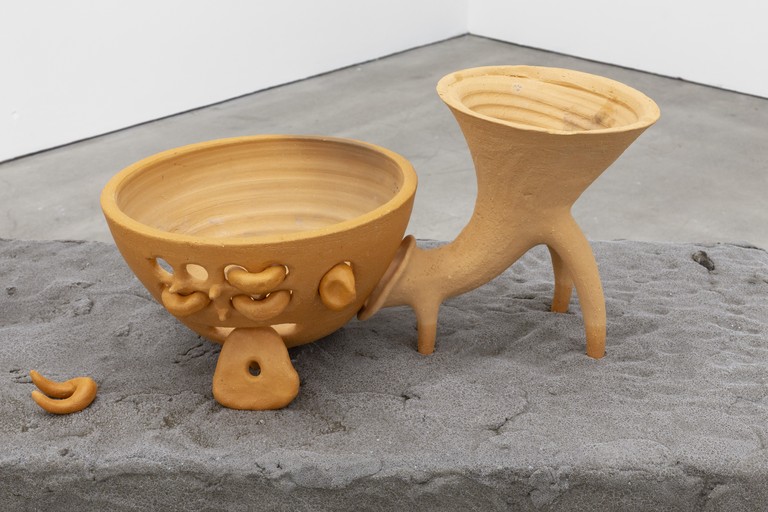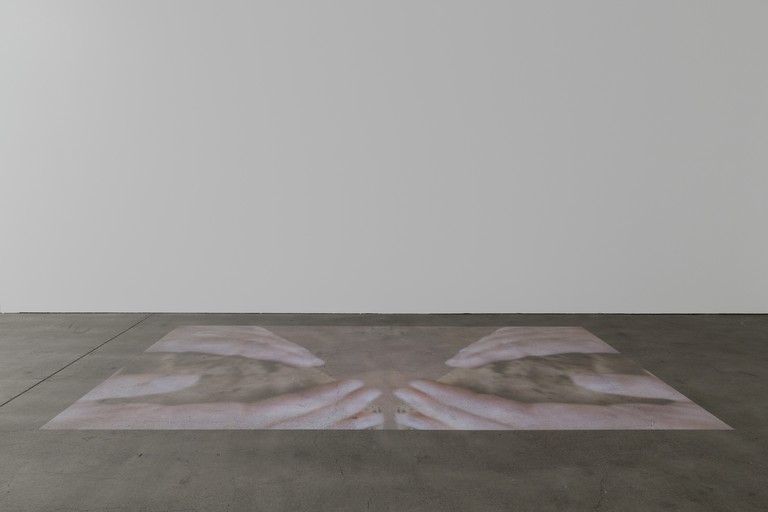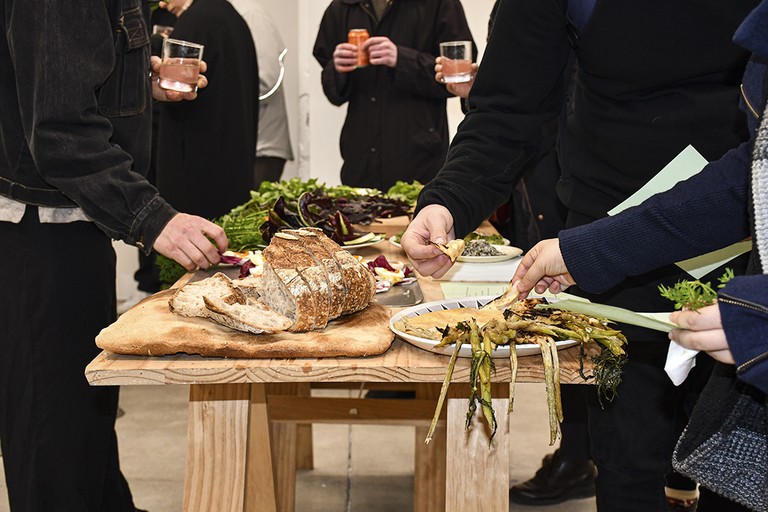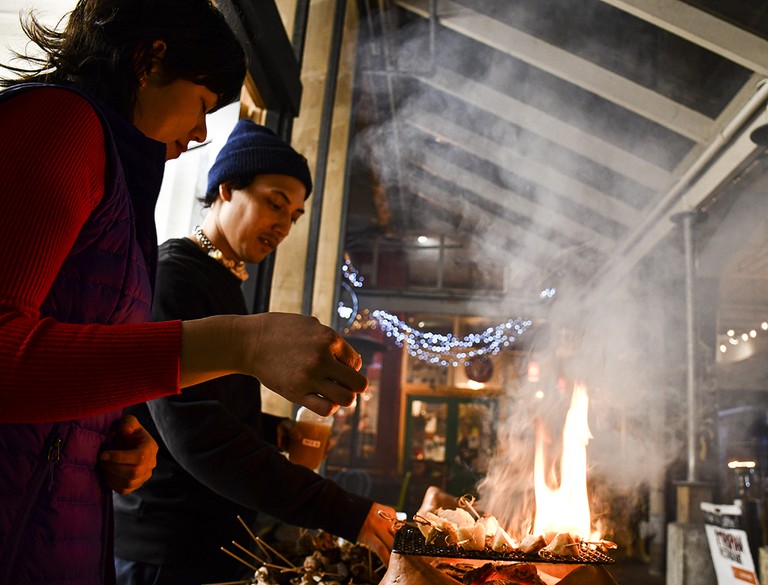Exhibition Essays
A Champloo of Sealed Earth
July 2021
A Champloo of Sealed Earth
Romesh Dissanayake
Champloo comes from the Okinawan word champurū, a stir-fry dish of bitter melon. It is used broadly to mean ‘mixed up’ or ‘stirred together’.

Ruby White, Pieces of, 2021, install. Image courtesy of Cheska Brown.
I.
A thing we’ve lost within the miracles of industrialisation and mass production, is that what we eat represents a process. A process traced back to communities—communities of critters, communities of growers, communities of transporters. As food sits stacked on our shelves in neat little pyramids, the intertwined web of connections that brings it there is hard to see. Left with no viable options out of consumerism in the age of the anthropocene, our choices invariably have an impact on these communities. However, just as a single droplet contains the essence of the sea, we hold the power to enact real change over a whole host of ecological, environmental and decolonial tasks set before us.
Ruby and I are at Jeremy’s place in Homebush in the Wairarapa. His house is built like an Italian villa. Built slanting with his own two hands, built not from Italian tile but from timber, concrete and corrugated iron. His patch of land is roughly partitioned by wild blackberry bushes and along the loose rows, amongst weeds, he grows raddichio, sprouting brocolli, cauliflower. His eyes glisten and dart when he tells us about the puntarella he has been growing for the past couple of months.
Ruby sits at the table with a cup of coffee, listening intently. “I’ve seen a video of that being prepared,” she says. “You have to push it through this guitar-string grate, huh?”
“Exactly," Jeremy says. “In Italy, they drop the thin slices into cold water once they’ve been cut. They curl up in shock ... leech out the bitterness.”

Ruby White. Pieces of opening menu. 2021. Image courtesy of Enjoy Contemporary Art Space.
Last year while I was working at a small wine bar in Chews Lane, Jeremy supplied us with produce. One day a small parcel of furry green almonds arrived with our vege order. Excitedly, our small kitchen team made them into a relish with mustard seeds; we confit them in olive oil; we braised them with octopus. But nothing really worked out ☹️. They were either too bitter or their outside skin, the forming shell, never really broke down. We hadn’t the patience or the skills to access the magic they contained. That’s the way with Jeremy’s produce. His vegetables speak of a mad obession—of frosty early mornings and crunchy slugs underfoot. His legs are bowed and tags flap constantly from the back of his inside-out skivvy. His raddichio is so bitter that even after tearing its red veined leaves and dousing them in olive oil and red wine vinegar, they remain intensly sharp and defiantly crunchy. The last time I visited his farm he pointed out a ewe whose milk he planned to use to make his own pecorino. In his shed a stack of innoculated logs cycle in and out of the walk-in cooler, sprouting mushrooms. Jeremy plans to open up his house to create an al fresco dining area; plans to build an outdoor oven to sit next to and be warm. Drink wine.
I can tell Ruby and Jeremy are getting along as I walk behind them on this tour of his farm. There is a kindred naivety about them. The kind that propels them forwards through their own individual practices. Searching for meaning among the jumble of misinformation, fear and clutter. With a handful of dirt, they inspect and peer into the future. Two pīwakawaka flirt around us as we walk. When we leave Jeremy hands me some puntarella to take home. It sits in my vegetable crisper drawer for two weeks before it starts to disintegrate. I scoop up the mush with the side of my hand and paste it to the side of the Kaicycle compost bucket, ready for the collection on Tuesday. That’s the way it is.
II.
A relationship with clay teeters between function and mode. Utility and ornament. Work and play. The body and mind, in a labour of creation, shape these dichotomies in a process so physical that its forms refer back to the maker—the foot, the belly, the shoulders, the neck. The clay body. A tacit transference of energy from soil to hands and hands to soil. A life cycle which begins and ends outside of its current keeper.
I fantasise these cookers will go on to have a life without me. I like that they have a dominance and energy as sculptures. They demand to be used and really, that is the most powerful engagement I can hope for. These cookers provide an experience that belongs to everyone (and they feed you!! v important imo).1
To make the cookers for Pieces of, earthenware clay is cut into small pieces and left to dry in the sun. Bone dry. It is then crushed down, blended with lithium subtrates, molochite and toilet paper. Water is added then it is left for a few days more to dry out. It is then wedged and again, left to dry. Ruby shapes the ceramic pieces through a mixture of wheel-thrown and hand-built forms, buffed to a soft sheen using terra sigillata—an ancient Roman clay slip. The process is laborious and time-consuming—testing for thermal expansion, prototyping ceramic grill tops and researching fuel alternatives along the way—however the cookers themselves are generous and playful.

Ruby White, Untitled (three piece), 2021, earthenware, lithium substrates and toilet paper, detail. Image courtesy of Cheska Brown.
They speak to the idea of formless growth. The descriptor ‘anarchic geometric’ fits with my thinking around artistic practice. Repetition in the physical and social realms, from the molecular to the super-sized. Omnipresent patterns in the behavioural, bodily, societal and natural worlds.2
At Enjoy Contemporary Art Space, the cookers stand on plinths made from a slurry of sand, water, flour and salt. Clay pieces on structures resembling dirt; from the outside looking in one might think these things regressive. Modern trends fetishise cooking over fire—the bucolic, the pastoral, an often misappropriated farm to table ethos. Upon closer inspection the plinths sparkle and glitter in the light, they droop as if in gradual motion, they crumble at the bottom where they meet the floor—the crashing of waves. The clay cookers sitting atop the plinths are puffy and dawdling like a plump and cartoonish Majin Buu in Dragon Ball. Playfulness has always been a core element of Ruby’s work. In a phone conversation she mentions the importance of play—and playtime—within an artistic practice.
It is a space where you are liberated from real world repurcussions. Especially if you are a minority, this kind of uncapped freedom of expression is rare. Free from feeling like shit, like you are unworthy or stupid. Play is the process of unlearning and relearning. Having that point of cuteness, softness and roundness is compelling, same with the food – it brings people closer together, opens up conversation. Sounds simple but you can’t take that for granted. 3
In another room a mirrored video loop is projected onto the concrete floor. The soundtrack is by Salina Fisher, a composer and recipient of the Douglas Lilburn residency. Salina connects to her whakapapa through the use of a Japanese zither instrument called the koto. The sounds of the traditional intrument are altered through the use of a reverb pedal and they hollow out the art space with a ghostly meditative resonance.
The video itself captures one of the early stages of working with clay, wedging (in this case spiral wedging which is a traditional Chinese and Japanese technique). Like the koto, the video has been mirrored, a simple (but effective) method to distort/ revisualise the process. I wanted to acknowledge this beautiful starting point.
The video reads as mesmerizing, rhythmic and bodily (vaginal). Shit and sex. Beginnings and ends. The mirroring suggests a parallel or alternative existence/ script/ perspective. 4

Ruby White in collaboration with Salina Fisher, Evert, 2021, single channel video, 01.35, audio: Salina Fisher, koto and reverb pedal. Image courtesy of Cheska Brown.
III.
A creative practice centered around food should seek to democratise pleasure and enjoyment. In an art space—which can only be as democratic and revolutionary as its internal structures allow—presenting food itself as the exhibition creates an opening for momentary chaos.
Ruby and I first connected in 2019 while I was planning a Korean Sunday lunch at Rita in Aro Valley. We bonded over the conceptual artist Rirkrit Tiravanija, who gave Asian artists everywhere a backdoor into high-minded and elitist art world spaces when he served pad thai in the middle of the exhibition space at the Paula Allen Gallery in New York. Springboarding off Duchamp’s notion of art being art if the artist says it is, Tiravanija placed cooking and food in the gallery space to challenge “generally accepted concepts of art” 5. Not all visitors realised the gesture was a form of exhibition, some assumed that the art was part of the catering service. What kind of unconscious biases were at play here?

Ruby White. Pieces of, opening night menu. 15 September 2021. Image courtesy of Enjoy Contemporary Art Space.
The term ‘relational aesthetics’ was coined in the mid-90s by art critic, historian and curator Nicolas Bourriaud and defined by him as “A set of artistic practices which take as their theoretical and practical point of departure the whole of human relations and their social context, rather than an independent and private space.”6 The participants become the art, but not as performers to be documented and analysed as art at a later date. They are the art and make it in realtime through consuming the food and engaging in conversation. This stimulus allows visitors to be aware of their bodies, their identities, their system of beliefs. The source of the ingredients and the methods of their preparation are presented with transparency and purpose.
I am standing behind a trestle table set up outside Enjoy Contemporary Art Space in Left Bank for the launch of Pieces of. As people pass they point and say, ‘Oh, look, free food!’. On the table three of Ruby’s cookers glow red from hot charcoal and walnut shells within. They are ruddy and from a chimeny at its centre Homer, the rotund cooker in front of me, billows up smoke. I dip a skewer of three mushrooms: swiss brown, brined tawaka and foraged wood ear, into a glass mason jar of sauce made from honey and nasturtium flower vinegar. People are waiting in anticipation, watching us grill. As they grow in number, I find myself slipping into the comfortable and familiar dynamics of a busy restaurant service. The consumer/food-preparer relationship is so hard to shake. There’s safety in it. There are unspoken assumptions for how we are supposed to engage with each other in public spaces. In art galleries we are to act contemplative and we do not raise our voices. In restaurants, we must ask politely when we order items from the menu and pose it as a question. May I...? Can I...? With these roles blurred and the setting misconfigured, we ask, which one are you? and, which one am I? The relational aesthetic.

Ruby White and Romesh Dissanayake at Pieces of opening. 15 September 2021. Image courtesy of Enjoy Contemporary Art Space.
In preparation for the launch of Pieces of, Ruby has baked celeriac from Jeremy’s farm inside of a dough made of equal parts of flour and salt, bound with water—a common cooking techniques where a whole vegetable or fish is baked in a salt dough. The baked ingredients are softly seasoned by the salt and less moisture is allowed to escape. The hardened crust is discarded afterwards. With the leftover dough from this process Ruby has baked a flat tray to serve bread from a local baker in Left Bank . I see a man break off a corner of this salt-crust tray and dip it into his glass of wine like they would do in Italy—instinctively. The parameters have shifted. I hand out the grilled mushroom skewers and watch them wander around the gallery space, bouncing, like floppy pigs ears.
These kinds of activations of the cookers later happen outside Enjoy Contemporary Art Space on the 14 and 21 of August, with the public welcomed to take part in a shared meal. A planned third activation was halted by a global pandemic resulting in a nationwide lockdown. The pieces currently sit inside the art space in limbo, waiting to be bought and rehoused—to continue the discussion of how we will choose to consume in the future in fields unknown.
-
1.
Ruby White, document shared with author, May 5, 2021.
-
2.
Ruby White, document shared with author, June 17, 2021.
-
3.
Ruby White, phone converstion with author, July 27, 2021
-
4.
Ruby White, document shared with author, June 29, 2021
-
5.
Felix Bröcker, "Food as a Medium Between Art and Cuisine: Rirkrit Tiravanija’s Gastronomic Installations," in Culinary Turn: Aesthetic Practice of Cookery, eds. Nicolaj Van Der Meulen and Jörg Wiesel (Bielefeld: Transcript Verlag, 2017), 173, http://www.jstor.org/stable/j.ctv1wxt0c.27.
-
6.
Nicolas Bourriaud, Relational Aesthetics (1998), quoted in "A Guide To Relational Aesthetics,” Something Curated, February 14, 2018, https://somethingcurated.com/2018/02/14/a-guide-to-relational-aesthetics/.
